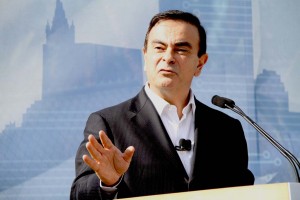Nissan has become the only one of the major Japanese automakers to post an increase in earnings for the January to March quarter, profits rising 7.2% despite the impact of the March 11 earthquake and tsunami that virtually shut the Japanese auto industry down.
The maker also reported that it expects to be back to full production at its home and foreign-based assembly operations by October, one to two months before arch-rival Toyota, which on Wednesday reports a 77% decline in profits due to a mix of factors including the March disaster and a sharp rise in the Japanese yen.
Nonetheless, Nissan, like its Japanese competitors, has been hard hit, and “We’re going to have to accept the fact that in some markets we’re going to have significant losses in market share,” acknowledged CEO Carlos Ghosn.
Nissan reported a quarterly net profit of 30.8 billion yen, or $347.5 million, compared with a loss of 11.6 billion yen. It also announced an 88.6 billion yen, or $1.1 billion operating profit for the final quarter of the Japanese fiscal year, which ended on March 31.
The operating income was about 10% ahead of the estimates of most analysts, particularly after adjustments were made to reflect the potential impact of the natural disaster that struck Northeast Japan and damaged or destroyed hundreds of automotive suppliers. Nissan was also hit by the rolling electric blackouts that followed the partial meltdown of the Fukushima nuclear plant.
The maker has so far lost production of hundreds of thousands of vehicles, both at its domestic and foreign-based assembly plants, and CEO Ghosn acknowledged that, “If you have no cars, there’s no way you’re (not) going to lose market share.”
The good news for the maker is that it had been building up inventory prior to the disaster to accommodate growing demand in a number of key markets, including the U.S. as well as Europe, where it was one of the few major Japanese brands growing demand.
So, even though the CEO admitted the current situation is “very frustrating,” and will bring losses in some markets, “2011 should (still be a time of) progress in terms of sales compared to last year.”
Nissan has been working with its suppliers in an effort to get them back up and running, and inside sources tell TheDetroitBureau.com that the maker has either been able to restore parts shipments from all but a dozen or so quake-damaged vendors – or find alternative sources.
The industry, overall, is still struggling to deal with shortages of plastic and rubber parts. But one of the biggest problems is with electronic microcontrollers used by the dozens in today’s automobiles. One of the biggest suppliers, Renesas, has announced it should be back to partial operation by next month and in full production by October.
Nissan’s relative good fortunes reflect a variety of factors including its mounting success in established markets, as well as growth in emerging economies, such as Russia and China. The maker has also been gaining momentum from its emphasis on green technology, such as the new Nissan Leaf – though sales of that battery-electric vehicle have so far barely pushed into the thousands.
The maker has also felt less of an impact from the steady appreciation of the yen, which actually had triple the impact on Toyota’s January – March quarter compared to the quake. Toyota produces roughly half of its global products in Japan while Nissan has pushed more and more output overseas, its home market plants now providing barely a quarter of its global volume.
The maker plans to shift production of two crossovers, the Rogue and the new Infiniti JX, to the U.S., for example.
But Ghosn has also reiterated a long-standing pledge to maintain home production at a minimum 1 million units.

